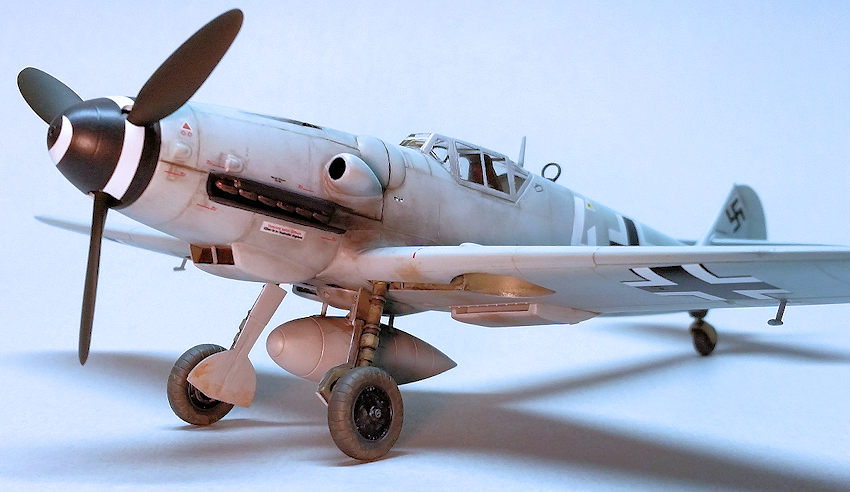
| HISTORY |
Academy 1/48 Bf-109G-5
| KIT #: | 2146 |
| PRICE: | $15.00 from a vendor |
| DECALS: | Two options |
| REVIEWER: | Jonathan Prestidge |
| NOTES: | Eduard seat belts added |

| HISTORY |
WWII saw the use of many famous fighter aircraft. The Bf-109 was among the most iconic aircraft of that conflict and certainly one that came to symbolize the Nazi regime. Even today, the shark-like shape exudes a sinister beauty that is at once captivating and frightening.
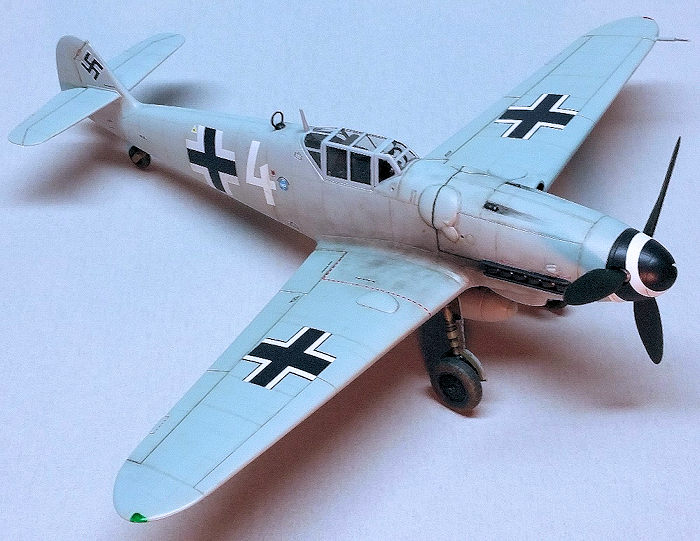 The
Bf-109 was contemporary to and nemesis of the British Spitfire. Like the
Spitfire, Bf-109 was in constant production throughout WWII. It was
continually upgraded and modified to keep it competitive with its
adversaries throughout the conflict. The 109’s airframe was adaptable, able
to take on larger engines of higher power. However, these “upgrades” added
weight and degraded the already tricky (treacherous?) handling
characteristics of the 109. In the hands of a skilled pilot the Bf-109 was
truly lethal but more 109’s were lost in accidents than were lost in combat.
The
Bf-109 was contemporary to and nemesis of the British Spitfire. Like the
Spitfire, Bf-109 was in constant production throughout WWII. It was
continually upgraded and modified to keep it competitive with its
adversaries throughout the conflict. The 109’s airframe was adaptable, able
to take on larger engines of higher power. However, these “upgrades” added
weight and degraded the already tricky (treacherous?) handling
characteristics of the 109. In the hands of a skilled pilot the Bf-109 was
truly lethal but more 109’s were lost in accidents than were lost in combat.
The G-6 was the most produced 109 variant. It was easily identified by the “bumps” on the upper engine cowl that covered its 13mm machine guns. The G-5 was essentially a pressurized G-6. Externally, the G-5 had a protrusion from the starboard side “bump” that covered the pressurization compressor. Photos also show dual-paned cockpit glass and a rubber seal around the rear of the engine cowling.
| THE KIT |
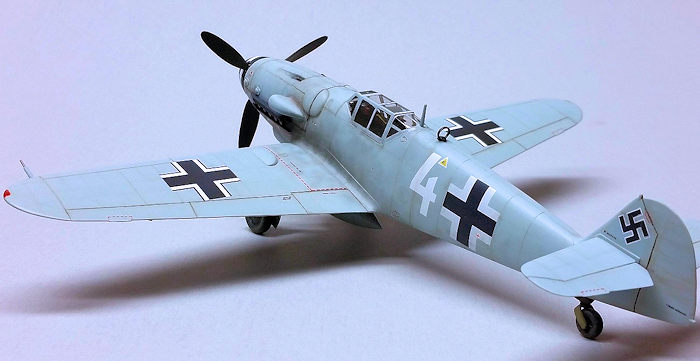 The
Academy 1/48th scale Bf-109G-6 was a re-boxed Hobbycraft kit with good
production quality, easy to follow instructions, and much better decals. As
with most Hobbycraft kits, the 109 series was cleanly molded with a simple
cockpit. The airframe detail was engraved but basic and there were no
posable control surfaces (slats, flaps, rudder, etc.). The clear parts were
also a bit of a letdown in that they didn’t fit well - the center section
being too short vertically and too narrow. The shape of the finished kit
looked true to the prototype though I admit to not being a rivet counter.
Thankfully, a G-5 starboard side “bump” was included in the kit parts.
The
Academy 1/48th scale Bf-109G-6 was a re-boxed Hobbycraft kit with good
production quality, easy to follow instructions, and much better decals. As
with most Hobbycraft kits, the 109 series was cleanly molded with a simple
cockpit. The airframe detail was engraved but basic and there were no
posable control surfaces (slats, flaps, rudder, etc.). The clear parts were
also a bit of a letdown in that they didn’t fit well - the center section
being too short vertically and too narrow. The shape of the finished kit
looked true to the prototype though I admit to not being a rivet counter.
Thankfully, a G-5 starboard side “bump” was included in the kit parts.
The decals in the kit were nicely printed with complete stencils and markings for two aircraft. The first was a G-6 flown by Oblt. Erich Hartman during October of 1943 in Russia. The second marking option was for an aircraft flown by Oblt. Emil Klade during January of 1944 in Greece.
| CONSTRUCTION |
I began removing the major parts from the sprues and cleaning them up. Next, parts that could be assembled prior to paint were glued together resulting in a series of subassemblies. As per my usual, I glued the upper wings to each fuselage half at this stage. Doing this allowed me to get a great wing root to fuselage join saving sanding and filing in this often tricky spot.
I then shot the
interior with Poly Scale RLM76 thinned with Future. The semi-gloss finish
allowed washes to flow freely and also made it easier to remove excess wash
from the high spots. Detailing continued in the cockpit with individual
dials cut from a decal sheet and placed on the instrument panel. I then
added an Eduar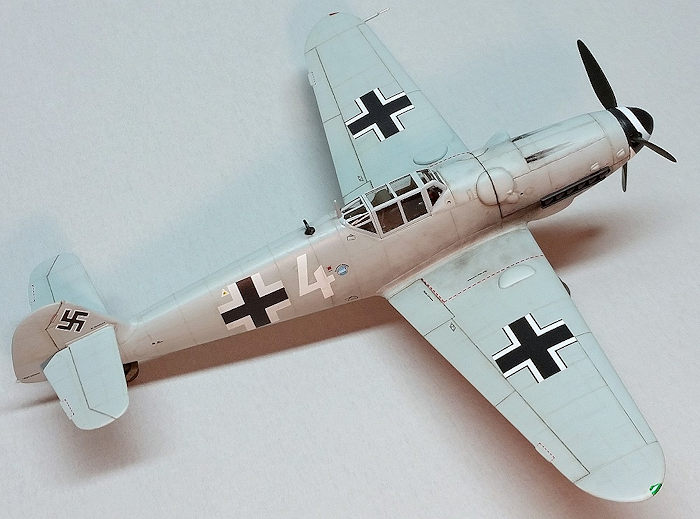 d
P.E. seatbelt. I also added an oxygen line made from twist tie wire. A thin
black soapy water wash was applied. Once the wash had dried, I drybrushed
the interior with a slightly lighter shade of interior gray.
d
P.E. seatbelt. I also added an oxygen line made from twist tie wire. A thin
black soapy water wash was applied. Once the wash had dried, I drybrushed
the interior with a slightly lighter shade of interior gray.
With the cockpit complete, I closed up the fuselage. The rest of the airframe was then assembled. I added a belly tank pirated from an Eduard 109. It fit with minor tweaking. The fit of the airframe was good needing just a bit of putty in the seams. Next came sanding around the cockpit area to try to get a better fit for the canopy. I also added a thin strip of styrene to the top of each side of the cockpit so the canopy would fit flush when closed.
I made a few tweaks to the engine cowl in the pursuit of accuracy. The kit parts have the cowl hinge end where the machine guns exit the top decking which was incorrect. I used a thin trimming of styrene to replicate the rest of the hinge terminating between the gun blisters. Once it was attached, I softened it with liquid cement and notched it with the back of an Exacto blade. Using a Hasegawa G-6 as a guide, I filled in and rescribed a few panel lines on the cowl as well. I then spent an hour or so sanding and polishing the airframe.
Finally, I added the canopy. The clear parts were dipped in Future prior to assembly. White glue was used to attach the canopy sections. Once dry, I masked the canopy using Tamiya tape and a new #11 blade.
| COLORS & MARKINGS |
 The
Bf-109 is over-modeled as it is and I certainly didn’t want to model another
Hartman 109 (no disrespect intended)! When choosing a color scheme, I
searched for actual photos of the plane I would model. I found several
photos on the internet of all blue G-5’s on the Eastern front. While I had
seen the “White 1” aircraft in the photos modeled, I had never seen the
accompanying “White 4” modeled. Given that I had the stencils needed in the
kit decals, all I had to do was find a white 4 and the correct upper-wing
crosses in the decal dungeon. I was able to modify white 4s from another kit
and I sourced the crosses from an aftermarket decal sheet.
The
Bf-109 is over-modeled as it is and I certainly didn’t want to model another
Hartman 109 (no disrespect intended)! When choosing a color scheme, I
searched for actual photos of the plane I would model. I found several
photos on the internet of all blue G-5’s on the Eastern front. While I had
seen the “White 1” aircraft in the photos modeled, I had never seen the
accompanying “White 4” modeled. Given that I had the stencils needed in the
kit decals, all I had to do was find a white 4 and the correct upper-wing
crosses in the decal dungeon. I was able to modify white 4s from another kit
and I sourced the crosses from an aftermarket decal sheet.
As a note regarding the markings - I did add a swastika to the tail of the model that was not shown in the photo. I could not tell if this symbol had been edited out of the photo (quite common). Since the markings of “white 4” in the photo were otherwise standard, I left it on (builder’s prerogative). Also, I added a white stripe to the spinner that may or may not have been there. It was impossible to see the spinner in the photos I could find. The swirling stripe was very common on German aircraft and I like it (again builder’s prerogative).
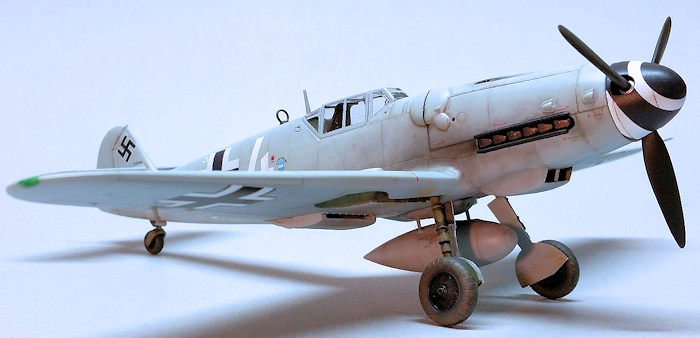 Polyscale
RLM76 was painted over the entire airframe. At this point I used pastels to
emphasize the panel lines and dirty the airframe a bit. The photos of “white
4” showed a relatively clean aircraft so I tried to keep things subtle,
adding just enough shade variation to enhance detail. I then sealed
everything with a coat of Future in preparation for decals.
Polyscale
RLM76 was painted over the entire airframe. At this point I used pastels to
emphasize the panel lines and dirty the airframe a bit. The photos of “white
4” showed a relatively clean aircraft so I tried to keep things subtle,
adding just enough shade variation to enhance detail. I then sealed
everything with a coat of Future in preparation for decals.
The kit supplied markings went down well. I modified the “4” to match the font on the actual plane. Once in position, the decals responded well to an application of Micro Sol. After weathering the decals, I gave the plane a final flat clear coat. Once dry, I added some chipping around maintenance panels with a silver Prismacolor colored pencil and painted the exhaust and other details. I used a mechanical pencil to add the rubber seal around the engine compartment and took off the sheen by painting over it with a dullcoat.
The landing gear and other fiddly bits were added at this time. Final detailing was then completed.
| CONCLUSIONS |
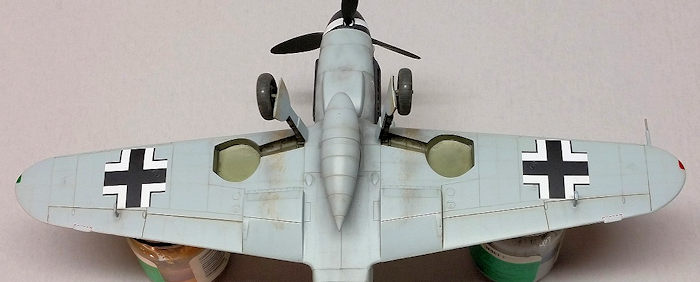 To
me there is something enjoyable about trying to build an older kit well
– I like the challenge. Though not a show model, I’m happy with the end
result. The finished kit looks good on the shelf. The simple color
scheme really shows off the sinister lines of the Bf-109.
To
me there is something enjoyable about trying to build an older kit well
– I like the challenge. Though not a show model, I’m happy with the end
result. The finished kit looks good on the shelf. The simple color
scheme really shows off the sinister lines of the Bf-109.
It is true that real 109s have slats and flaps opened up when on the ground. The lack of these features is the main failing of this kit. Currently there are better kits of the Bf-109G. The Hasegawa and Eduard offerings are much nicer and more accurate. They are also more complex and can be much more expensive. If you can find it really cheap then this kit is a viable option. Also, if you are like me and have this kit already, don’t be afraid to build it. Finally, it is well suited to newer modelers due to its simplicity.
11 November 2016
Copyright ModelingMadness.com
If you would like your product reviewed fairly and fairly quickly, please contact the editor or see other details in the Note to Contributors.